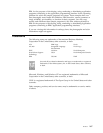
source=NET;
sub_source=SNMP-TRAP;
origin=$SOURCE_ADDR;
END
CLASS Authentication_Failure_Cisco
SELECT
1: ATTR(=,$ENTERPRISE), VALUE(PREFIX, "1.3.6.1.4.1.9");
2: $TYPE = 4;
3: ATTR(=,"authAddr");
FETCH
1: IPNAME($SOURCE_ADDR);
MAP
hostname = $F1;
originating_address = $V3;
END
# For Cisco routers, because we know the interface generating the trap,
# we map ’linkUp’ traps to ’linkDown’ CLOSED events
CLASS Link_Down_Cisco
SELECT
1: ATTR(=,$ENTERPRISE), VALUE(PREFIX, "1.3.6.1.4.1.9");
2: $TYPE = 3;
3: ATTR(=,"ifIndex");
4: ATTR(=,"ifDescr");
5: ATTR(=,"ifType");
6: ATTR(=,"locIfReason");
FETCH
1: IPNAME($SOURCE_ADDR);
MAP
hostname = $F1;
sub_origin = $V4;
status = CLOSED;
interface_index = $V3;
interface_description = $V4;
interface_type = $V5;
reason = $V6;
END
Object Identifier to Name Translation
The selection of an attribute is based on its name. With adapters that receive
SNMP trap messages, the standard way of naming attributes is to use object
identifiers (OIDs). For example, SNMP variable ifDescr is named 1.3.6.1.2.1.2.2.1.2.
Using SNMP object identifiers in SELECT statements is not very convenient.
Additionally, since the SNMP variable ifDescr is part of a table, it will be indexed
by the interface number. If the interface number is 2, the received object identifier
will be 1.3.6.1.2.1.2.2.1.2.2. Without some knowledge of the Management
Information Base (MIB), the SNMP adapter has no way to translate an object
identifier into a more understandable name, or to extract key parts from an object
identifier.
An object identifier file (tecad_adaptername.oid) for SNMP-based adapters contains
OID-to-name mappings for some SNMP variables. You can add or modify this file
as needed. The format of an object identifier file is:
name object_identifier
For example:
"authAddr" "1.3.6.1.4.1.9.2.1.5"
"ifDescr" "1.3.6.1.2.1.2.2.1.2"
160 IBM Tivoli Enterprise Console: Adapters Guide


















